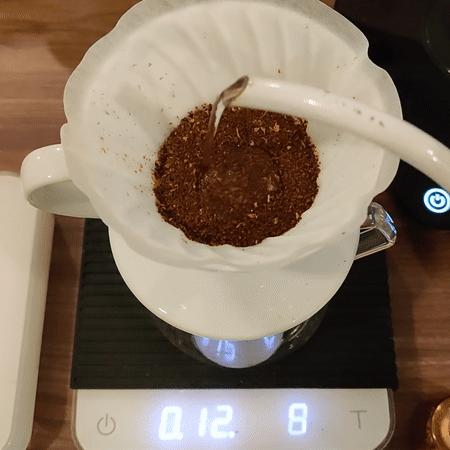Pre-infusion occurs differently for pour over and espresso. With pour over, pre-infusion is done to ‘de-gas’ the coffee grounds and force the carbon dioxide out. On the other hand with espresso, pre-infusion ensures that the coffee grounds receive an even amount of water during extraction.
Pour Over
You may have noticed our baristas pouring water in short intervals when preparing pour over. For the first pour, a small amount of water is poured onto the bed of coffee grounds. This is a pre-infusion process that causes a coffee bloom. Some people also call this a 'blooming 'process.

This is done to wet the coffee grounds enough to raise the temperature and release gases. If you see a lot of water moving through the filter, you are probably using too much water to bloom. The magic of blooming occurs because carbon dioxide (CO2) that has been trapped inside the grounds from roasting, is being forced out. It is essential to expel CO2 because CO2 will try to repel water. Having CO2 remain inside the coffee grounds is counterproductive because you will not get a good extraction of flavors since water is being rejected.
During 'de-gassing', which is when CO2 is being released, the grinds expand and rise and therefore, "blooms". Water replaces the gases that have been forced out and consequently, the pre-infusion phase is done and extraction begins! The amount of bloom you see greatly depends on the roast profile, as well as the temperature of the water you are using to brew. It does not necessarily mean that the coffee is not fresh (do check the roast date with your local roaster). A lighter roasted coffee tends to bloom less as it inherently has lesser carbon dioxide compared to a darker roast.
Espresso
Pre-infusion with espresso is slightly more complicated. It's a more intense process to extract coffee at a higher pressure but the outcome is the same as in a pour over when hot water meets coffee grounds - gases are being forced out. Just as you can see the effects of CO2 being released in a pour over through the bloom, you can see the effects in espresso too.


Notice the bubbles? These micro bubbles are CO2 gas, formed on the surface of the crema as carbon dioxide tries to escape. The trapped gas in the crema is essentially trapped flavors, and these are usually the first to hit the tongue. However the goal of pre-infusion for espresso is not to release CO2, but rather to ensure that the coffee grounds evenly receive the same amount of water flowing through once extraction begins, hence resulting in a more uniform extraction. If coffee grounds are not leveled evenly, there is a risk of what is called "channeling".
The concept is kind of similar to baking a cake. If the cake batter is not evened out in the tin before being popped into the oven, the cake will turn out unevenly baked through as some parts will either be over-baked or under-baked. With "channeling", when water is presented with a path of low resistance to flow through, it will do so. But because of water only passing through this path, these coffee grounds along the path of low resistance become over-extracted and the surrounding areas under-extracted. This leads to uneven extraction.
So how does pre-infusion help? Pre-infusion is like using a spatula to level out the cake batter in the tin first before putting it into the oven. The general idea is to encourage water to flow evenly. The coffee grounds are first soaked to low pressure and low water flow (where temperature remains constant throughout) during pre-infusion before fully extracting and brewing to create an espresso. A higher pressure is not required during pre-infusion because we do not want to start extraction yet. The reduction in pressure and water allows the grounds to be evenly saturated, fusing the puck of coffee together first, thus eliminating channeling.
Pre-infusion comes in various forms and when going into technical aspects, it is a complex topic that requires quite a fair bit of experimentation. The amount of pressure and length of the pre-infusion cycle paired with different types of coffee can render several different results.
Our knowledge of pre-infusion of espresso is based on several observations and outcomes that we have experimented with. We can’t be sure if it’s the pre-infusion that majorly affects the outcome or a by-effect that affects the extraction.
What are your experiences with pre-infusion for both pour over and espresso making? Share your observations with us in the comments below! We are still learning and would love to gain some insights from you too!
